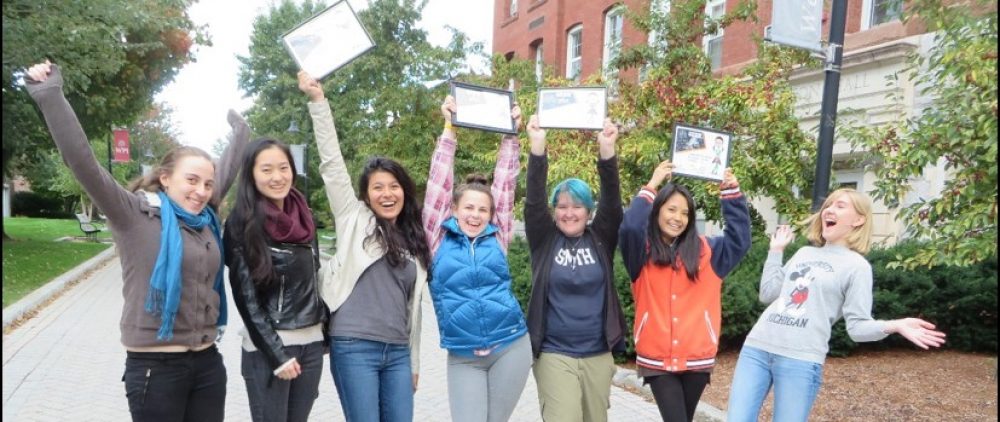An Education: Science Fellows Teach Hands-on Lessons in Local K-12 Schools
The 15 students in Kate Parrott’s seventh grade science class at JFK Middle School in Northampton gathered eagerly around their lab tables, beakers and measuring cups at the ready.
All eyes turned to the front of the classroom where Zuliat Owoade ’16 was giving instructions for a hands-on lesson about chemical reactions.
Owoade led the students carefully through the steps of an experiment combining vinegar, baking soda, dish soap and yeast mixed with warm water. Meanwhile, her teaching partner, Kyle Boyd ’15, made the rounds of the lab tables to ensure that each team of safety-goggle- wearing students was making progress.
“Ok guys,” Owoade said, when the hubbub over the fizzy mixture in the beakers had died down a bit. “What did you observe from your first experiment?”
“Bubbles!” one girl shouted out.
“Can someone guess what the gas was that made them?” Owoade asked.
“Carbon dioxide!” came the reply.
Owoade nodded her approval, as she wrote the equation for the chemical reaction the students had produced on the board.
The middle school lab was the culminating assignment for Owoade and Boyd, both participants in Smith’s January Science Teaching Fellowship Program. They were among 10 science students selected for the grant-funded program, which trains Smithies for one-week teaching stints in local public schools.
Thomas Gralinksi, who oversees the fellowship assignments as outreach coordinator for the Center for Community Collaboration, said Smith’s five-year-old program is unique in targeting science majors for classroom training. This year’s fellows taught in kindergarten and grades 3, 4, 5 and 7 in Northampton over the January Interterm.
“The program offers a way for science students to actually experience classroom teaching,” said Gralinksi, who is himself a former high school teacher. “Our students learn communications skills and how to break concepts down for different grade levels. Those are really good skills to develop whether or not they plan to go into science education.”
Topics covered in a course for fellows first semester covered public school standards, lesson plans and classroom management techniques, Gralinksi said.
Students also met with local K-12 classroom teachers before their one-week practicums to help tailor lessons to specific class needs and grade levels.
Nancy Cai ’17 said the training she received as a science fellow was “like being in boot camp”—albeit an enjoyable one.
Cai, who is majoring in neuroscience, said the experience of teaching fourth graders at Jackson Street School helped broaden her perspective. “When you’re a science major at college, it’s like doing a Ph.D.—you only know your own area,” she noted.
“This gave me a chance to get outside of that. It taught me to be flexible.”
Tori Wolf ‘16, another of this year’s teaching fellows, said the program helped her realize she does not want to be a classroom teacher. “You basically have to be the perfect human being to do that,” she said, with a smile.
Teaching elementary school students helped her learn how to communicate scientific ideas to “a wide range of personalities,” said Wolf, who is majoring in computer science.
“I was really amazed by how interested the kids were in science,” she added.
Gwen Agna, principal of Jackson Street, said teachers and students at her school have benefited from having Smith fellows in the classroom.
“Having role models of young women in science is wonderful, especially for our girls,” Agna said. “The program is also a really good boost for hands-on activities that teachers find hard to do without extra help.”
Parrott, who has worked with Smith science fellows at JFK for the past four years, agrees.
“There’s a palpable difference when the students have a lab,” Parrott said. “Those hands-on activities give kids who aren’t traditionally book smart a chance to shine.”
For Owoade, who is majoring in computer science and biology, teaching middle schoolers sparked reflections about her own path in the sciences.
“I got interested in science at this same age,” she said. “But in Nigeria, we weren’t used to a lot of labs. If I’d had these kinds of activities, I’d have been even more excited about science. You can actually see what you are reading about.”
Owoade, who is interested in a career in medicine, is now also thinking about participating in Teach for America. “I’ve learned teaching is about social and emotional things for kids,” she said. “You do everything for them when you teach.”
Boyd, who is majoring in biology, said being a science fellow gave her a valuable glimpse of what goes on “behind the scenes” in a classroom—including how to adapt when things don’t go as planned with a lesson.
She also learned something about seventh graders. “Everyone talks about the terror of middle school but really, the opposite is true,” Boyd said.
How did the JFK students feel about having Smith science fellows in class?
“I enjoyed it,” said Sara Grimaldi, as she helped clean up after the baking soda experiment. “They seem very knowledgeable and seem to know what they’re doing.”
“It was cool to have someone else teaching,” added classmate Tommy Harte. “You see things from a different viewpoint.”
